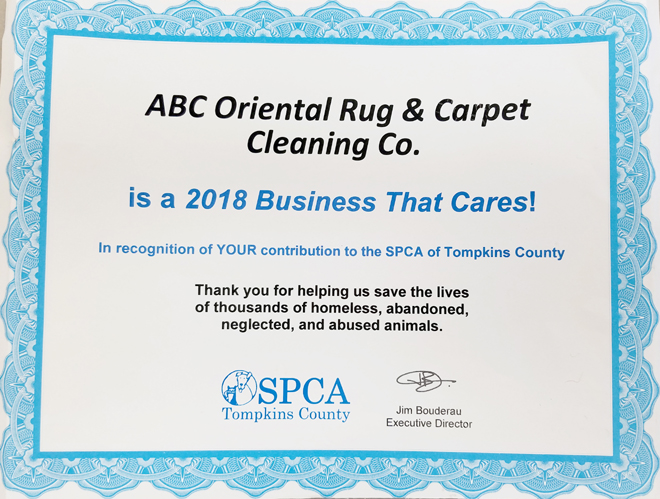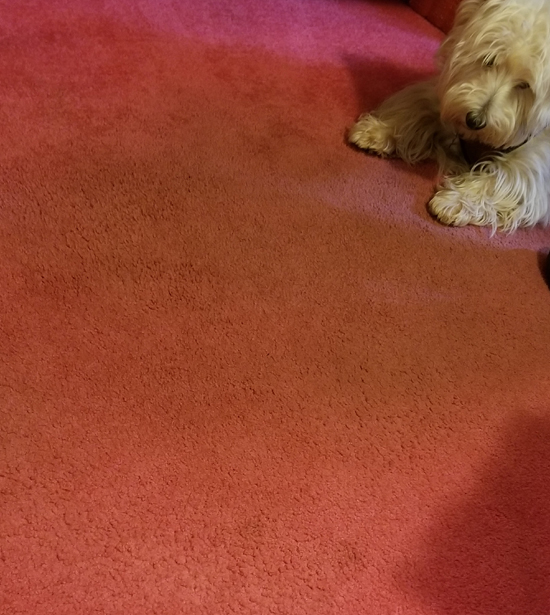ABC MONTHLY NEWSLETTER
JULY 2019
Welcome to Our Monthly Newsletter!
We hope you will enjoy this month's articles.
This month's topics are:
AREA RUGS
MISCELLANEOUS
CARPET
JULY SPECIALS
If there is a topic you would like us to cover in one of our upcoming newsletters, please call us at
607-272-1566
or contact us by clicking here.
GREAT NEWS!
GOT QUESTIONS?
NOW YOU CAN TEXT US at
607-272-1566
JULY 2019
AREA & Oriental RUG Cleaning Special...
Clean one Rug Get Second Rug
of Equal or Lesser value cleaned at
50% OFF!!**
PLUS
10% of the Cost of
URINE ODOR REMOVAL
from your Area or Oriental Rug
will be Donated to the TC SPCA!
Free Pickup & Delivery included!
**Terms:
- MINIMUM in plant cleaning of $150.
- MINIMUM cleaning of $300 for rugs picked up and delivered outside of Tompkins County.
- Rug of equal or lesser value will be considered 'second rug of equal or lesser value cleaned at 50% off.'
- Additional discounts do not apply.
For PICKUP & DELIVERY
please call 607-272-1566
to schedule an appointment.
or
Bring in your rugs to our cleaning plant at 130 Cecil Malone Drive Ithaca
TURKISH RUGS
HISTORY
EARLIEST RUGS
Turkish rugs, both flatwoven (or kilims with no pile) and hand-knotted rugs (with pile), have been woven in the various Turkish regions for centuries. Unfortunately, not enough evidence has thus far been obtained to provide the answer as to when these rugs actually first appeared.
Archaeological excavations have proven that flatwoven rugs (kilims) have been produced in the Anatolia region of Turkey since at least the Neolithic period.
The earliest specimens of hand-knotted rugs discovered thus far were in Turkish regions in excavations carried out on Turkish burial mounds. This evidence confirms the belief this first type of hand-knotted rug was most likely first woven and used by the Turks.
NOMADIC CULTURE
Hand-woven textiles were a necessary household item for people living in Central Asia where the Turks originated. The migratory life of the nomads made it necessary to have on hand a variety of woven woolen textiles such as tents and pile rugs, as well as kilims (flatweaves), felts, coverings, sacks, and satchels.
The nomad Turks used the wool from their animals to weave rugs and they brought their rug weaving tradition with them when they migrated from Central Asia toward the West.
TURKISH RUGS - DESIGNS
The rug designs of the Turk nomads reflected their lives as influenced by the various climatic and geographic conditions they experienced. Along the way they also added influences from their new living conditions and the impact of local cultures. They thus continued their tradition, though with modified colors and designs.
The values of a particular weaving period may be reflected in the twist and quality of the wool, the manner in which the dye was manufactured, and from what plants or insects it was produced, the fineness or looseness of the stitch and, most important of all, the symbolic significance of the motif.
PIOUS ENDOWMENTS
The Turkish tradition of pious endowments is the major reason rugs have managed to come down to us from the depths of the past. The benefactors who, with their own modest resources, built the mosques to be found in even the smallest village. They then furnished them with rugs and kilims and added to these several of the finest specimens produced over the centuries by the looms in the various houses. There were also a number of prayer rugs specially woven for the mosques. It is thanks to this tradition of pious endowment that the cultural heritage of carpets and kilims has survived to the present day.
TURKISH RUG WEAVING TODAY
Today, rug weaving still continues in villages in Anatolia, although the number of carpets being made has been reduced.
It is noteworthy to mention the successful DOBAG project (a Turkish acronym for Natural Dye Research and Development Project,) which had produced superior carpets since 1981 with natural plant dyes and traditional Turkish motifs in the villages in northwestern Anatolia.
Unfortunately, as of the end of 2018, the annual production for the Dobag was only 30 pieces, mainly woven by older weavers, and the project was essentially terminated.
REPUBLIC OF TURKEY (TURKIYE) TODAY
Turkey (officially the Republic of Turkey as of 1923) is a country mainly located on the Anatolian peninsula in Western Asia (also known as Asia Minor) with a small region in Thrace in the Balkan region of SE Europe.
Addendum: Although in 1923, Turkey wished to be called Turkiye, it wasn't until December of 2021 that the country changed officially changed its name to Turkiye (tur-key-yay) in order to disassociate the name from that of the bird and to better represent its culture and values. (For our purposes, we will refer to Turkiye as Turkey in this article.)
Turkey is bordered by the Aegean Sea in the west, the Mediterranean Sea in the south and the Black Sea in the north. Armenia, Iran, and Azerbaijan are on the east, Georgia in the northeast, Bulgaria and Greece in the northwest, and Iraq and Syria in the southeast.
Turkey shares maritime borders with Cyprus, Egypt, Northern Cyprus, Romania, Russia, and Ukraine.
There are two narrow straits in northwestern Turkey, the Bosporus,
which connects the Black Sea with the Sea of Marmara, and the
Dardanelles, which connect the Aegean arm of the Mediterranean Sea with
the Sea of Marmara.
Turkey is more than twice the size of Germany or slightly smaller than the US states of Texas and Louisiana combined. It has a population of more than 82 million people. The largest city is Istanbul. The second largest city and the national capital is Ankara.
Turkish is the official language with Kurdish and Arabic also spoken.
REGIONS OF TURKEY
Turkey can be subdivided into seven major geographical regions:
MARMARA REGION
This region is the most densely populated in the country and is located in the northwestern part of the country on both the continents of Europe and Asia. Turkey’s largest city, Istanbul, is located here.
BLACK SEA REGION
This
region is a long stretching mountainous region along the Black Sea with
a predominantly rural population. Major cities are Samsun, a Black Sea
port, the port city of Zonguldak, and Trabzon which was a main port on
the historical Silk Road.
AEGEAN REGION
This region is one of Turkey’s prominent tourism centers. It shares much of the history of Ancient Greece and is home to the city-states of Ephesus Miletus, and Bodrum (formerly Halicarnassus).
MEDITERRANEAN REGION
This region consists of a mountainous strip of land along the Mediterranean Sea. The Taurus Mountain range in the region separates the Mediterranean coastal area from the Anatolian Plateau. The Turkish Riviera, with the two popular resort towns of Alanya and Antalya, is located here.
CENTRAL ANATOLIA
This historical region is the heartland of Turkey. It is home to the country’s capital, Ankara, and other major cities like Konya and Kayseri.
Cappadocia is also located in Central Anatolia. This is an ancient region between Lake Tuz and the Euphrates, famous for its ‘fairy chimneys’. Erosion has shaped the soft volcanic rock into thousands of strangely shaped towers and this area has become a favorite of hot-air balloon fans.
SOUTHEAST ANATOLIA
This region is also known as Turkish Kurdistan. It borders Syria in the south and Iraq in the southeast. In ancient times, Southeast Anatolia was part of the historical region of northwestern Mesopotamia, the site of the earliest urban civilizations. The world’s oldest stone structures were erected by an unknown civilization between 9,600 and 8,200 BCE, a time that predates Stonehenge by 6,000 years!
EASTERN ANATOLIA
This region was formerly part of western Armenia. It is the region with the lowest population density. The main economic activity is agriculture and animal husbandry. Van is a major city near the Turkish border with Iran and lies on the shores of Lake Van, the largest lake in Turkey and one of the world’s largest lakes with no outlet. The university town of Erzurum is located here and is a popular winter sports destination in Turkey.
MAJOR TURKISH RUGS
Continue reading here for an overview of nine of the major Turkish rugs with photos.
For an in-depth article on Turkish Rugs Motifs, please click here.
HOT DOGS!
July 4th and hot dogs always seem to go together. July 4th in America has evolved into one of our most favorite and fun-filled family celebrations. When asked, "What does July 4th mean to you?" most would say, "Hot dogs and Fireworks!"
This could be either a bad or a good answer. Perhaps we are too many light years away from our fight for independence and, though we must express our sincere gratitude for our freedom, one could say the thought of eating our favorite food and the sight of fireworks while gathering with friends and family is not an unimportant reason to love the July 4th holiday!
Or, one could even argue eating hot dogs on July 4th, at baseball games, and for that matter all throughout the summer, is as American as apple pie!
Not only do hot dogs abound on the July 4th weekend, July is National Hot Dog Month. Although some nutritionists suggest we shun them, for most of us they are probably the best picnic and family gathering food ever because everyone from grade schoolers to grandpa loves them. For that reason alone (though we probably should exercise moderation) we should try to keep the nutritionists at bay at least for the summer.
HOT DOGS & BASEBALL
Did you ever wonder how hot dogs and baseball are linked? According to the National Hot Dog & Sausage Council (NHDSC), vendors would sell 'hot dachshund sausages' during baseball games at the Polo Grounds in NYC in the late 19th and early 20th centuries. Legend says in 1901, a cartoonist for a Hearst newspaper, Tad Dorgan, sketched a cartoon of a real dachshund dog, smeared with mustard, in a bun. Dorgan didn't seem to be able to spell the name of the dog and instead wrote 'get your hot dogs' for the cartoon caption. Apparently, Dorgan's cartoon has never been found to prove this, but it certainly makes for a good story!
Besides its early association with baseball parks, hot dogs are just about the most perfect food to enjoy while cheering on a favorite team. They are easy to prepare, inexpensive, and easily portable. Hot dogs are eaten most often between Memorial Day and Labor Day, incidentally coinciding with the peak of baseball season.
HOT DOG HISTORY
A timeline of important facts in the history of the hot dog can be noted as follows:
-
1487 - The frankfurter supposedly was first developed in
the city of Frankfurt in Germany. In fact, in 1987, the City of
Frankfurt celebrated the 500th anniversary of the hot dog. It
is also possible the original 'dachshund' or 'little dog' sausage was
developed in Coburg, Germany in the late 1600s by a German butcher who
then went to Frankfurt to promote his product. However, people from
Vienna, Austria say the term 'wiener' proves their city (Wien) was the
birthplace of the hot dog.
- 1800s - German immigrants brought sausages, as well as dachshund dogs to America.
- 1860s - Reports of a German immigrant selling hot dogs with milk rolls and sauerkraut in New York City's Bowery from a push cart.
- 1871 - Charles Feltman, a German baker set up the first Coney Island hot dog stand selling dachshund sausages in a milk roll.
- 1890s - Historians find mention of 'hot dog' in college campus magazines.
- 1893 - 'Little dog' sausages were introduced by St. Louis bar owner and German immigrant Chris Von de Ahe, who happened to own the St. Louis Browns baseball team.
More than likely, though, the North American hot dog came from a variation of the common European sausage, brought in by butchers of many different nationalities, which then spread throughout the country.
COOKING PERFECT HOT DOGS
When
cooking hot dogs, temperature is the most important consideration for
the best and tastiest hot dogs. They must be hot enough but not too
hot. The optimum temperature is between 150 and 160 degrees. Hot dogs
cooked at under 140 degrees will be spongy and dull tasting. Cooked
over 165 degrees, they get bloated and quickly start to dry out.
A
two-step process of poaching and then grilling can result in perfect
hot dogs. First, heat up a saucepan to 155 degrees. Then, drop the heat
to low. Put in the meat and wait 10 minutes. A perfectly heated hot dog
will be the result. But since we all expect a grilled hot dog, quickly
put them on a hot grill and in a few seconds, they will have a nice
color. Remove them instantly and serve.
Of
course, in reality, everyone has their favorite way of cooking and
eating hot dogs. What is really fun about hot dogs as well, is how
creative you can get with condiments. Here are some ideas: Yellow, Dijon
or spicy mustard, ketchup, mayo, chutney, BBQ sauce, Creole or chili
sauce, sauerkraut, sweet pickle relish, dill pickle slices, jalapenos,
sliced or diced peppers, grated cheddar, feta, blue, goat, cream
cheese, nacho cheeses, and sour cream, etc.
Hot
dogs are served in 95 percent of homes in the United States. Fifteen
percent of hot dogs are purchased from street vendors and 9 percent are
purchased at ballparks, according to statistics from the Heartland
Buffalo Company.
The National Hot dog and Sausage Council (NHDSC) estimates we will consume more than 150 million hotdogs during the 3-day July 4th weekend of 2019!
Enjoy. And check out the descriptions of some regional hot dogs below and on the right:
REGIONAL HOT DOGS
To find out more about hot dogs and mouth-watering photos of regional favorites, please continue reading here.
FIREWORKS SAFETY
BEWARE OF FIREWORKS
Fireworks are a much-loved tradition of the July 4th holiday and they can and should be used safely. But beware, because the 4th of July is also one of the busiest days of the year for house fires and injuries. Even the most common fireworks, such as a sparkler, can start a fire.
Fireworks safety is a major concern because the problem with fireworks is if handled in a reckless manner, there are no second chances. Nearly two-thirds of fireworks-related injuries are caused by backyard fireworks, including firecrackers and bottle rockets. About 20 percent of injuries are caused by firecrackers and 19 percent by sparklers.
FIREWORKS INJURIES
According to the National Fire Protection Association (NFPA), the most frequent injuries from fireworks are:
- Hand or Finger - 36%
- Head, Face, and Ear - 19%
- Eye - 19%
- Trunk -11%
- Leg - 10%
- Arm -5%
More than half of the injuries from fireworks are burns.
A new hazard is the use of toy drones flying near fireworks. It is against the law because it is incredibly dangerous. A drone that catches fire can land anywhere, including on people. It literally becomes a flying firebomb.
ILLEGAL FIREWORKS
To learn more about fireworks safety, please continue reading here.
RESIDENTIAL CARPET STYLES
The number of residential carpet styles available on the market today can make choosing the best option for your particular needs seem overwhelming.
Fortunately,
most of these residential carpet styles can fit into 4 main categories.
Understanding the pros and cons of each category can make choosing
wall-to-wall carpet much easier and a more informed decision as well.
LOOPED OR CUT PILE RESIDENTIAL CARPET STYLES
All
carpeting begins as looped. To make certain carpet styles, the tops of
the loops are sheared off to make a cut pile. A combination of cut and
loop can be used to produce a sculpted or carved look or an abstract or
geometric patterned carpet.
WHAT DETERMINES THE DURABILITY OF RESIDENTIAL CARPETING?
The durability of a carpet can be influenced greatly by the particular style but it is important to remember it can also be influenced by the following factors:
Face Weight
The
face weight of a carpet is the weight of the carpet pile measured in
ounces per square yard of carpet. This is important but should not be
the only quality measurement of a carpet and it is not always the best
way to determine durability.
Carpet Density
How close together the fibers are stitched into the carpet backing determines the carpet density. If 2 carpets are of the same fiber type and style, the one with the higher density would be a more durable carpet.
Fiber Twist
This is one of the best indicators of carpet durability and quality. The fiber twist is the number of times the strands of fiber are twisted together in a one-inch length of fiber. The formula is called the carpet's twist number or turns per inch (TPI).
Type of Fiber
Residential carpet styles come in many different types of fibers, all having different characteristics. The most common are Nylon, Olefin, Polyester, Triexta, and Wool. Some work better in certain situations than others. Please see our article on purchasing new carpet here.
Manufacturers' Warranties
All
carpets come with manufacturers' warranties. Some carpet styles come
with better warranty terms than others. These terms can often be
confusing or difficult to understand.
Make
sure to work with a professional carpet retailer to thoroughly
understand the length of a warranty and exactly what it covers.
THE FOUR MAIN CATEGORIES OF RESIDENTIAL CARPET STYLES
- Saxony - a cut pile available in straight or textured appearance producing fibers that stand straight up and are cut into even lengths.
- Frieze - a cut pile with long fibers that have a high twist
- Berber - a looped pile.
- Cut and Loop - these have some cut and some looped fibers that are combined to make a pattern in the carpet
For more information about the 4 major categories of residential carpet styles, please continue here.
THANK YOU!! WE LOOK FORWARD TO CONTINUING TO SERVE YOUR TEXTILE CLEANING AND REPAIR NEEDS!
Get New Posts Right To Your Inbox!
Get our monthly newsletter, just like this one, delivered right to your inbox each day. Just sign up and we will send you the best new articles and videos as they become available.
Your email address will NEVER be spammed, sold, or shared. You are welcome to unsubscribe at any time with the link in the email.
"The Cleanest Clean You've Ever Seen."
by
ABC Oriental Rug & Carpet Cleaning Co.
130 Cecil Malone Drive Ithaca, NY 14850
607-272-1566

ABC
Carpet & Rug
Spotting Guide

ABC Oriental Rug & Carpet Cleaning Co. has been family-owned and operated in Ithaca and surrounding areas for more than 48 years.
Our company is a reflection of our family name and pride.
Please Like us on Facebook!
for more information and to find out what we are doing at our business and in the community!
Stay Connected!
Links to Our Services
Allergy Cleaning
Area Rug Cleaning
Oriental Rug Cleaning
Rug Hand & Machine Repair
Upholstered Furniture Cleaning
Tile & Grout Cleaning & Sealing
We are proud sponsors of the SPCA of Tompkins CO:




